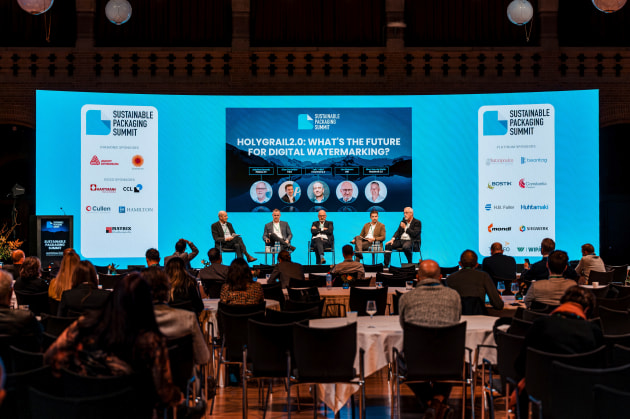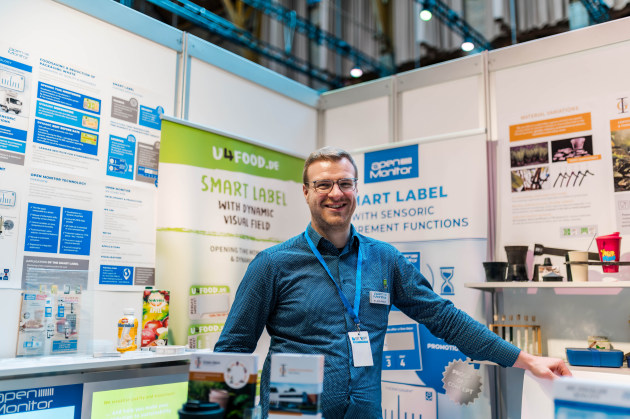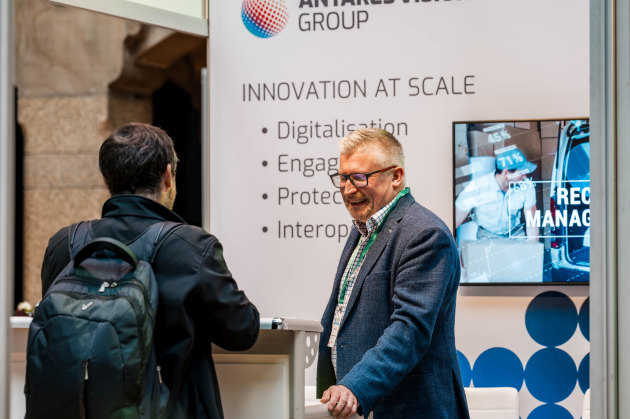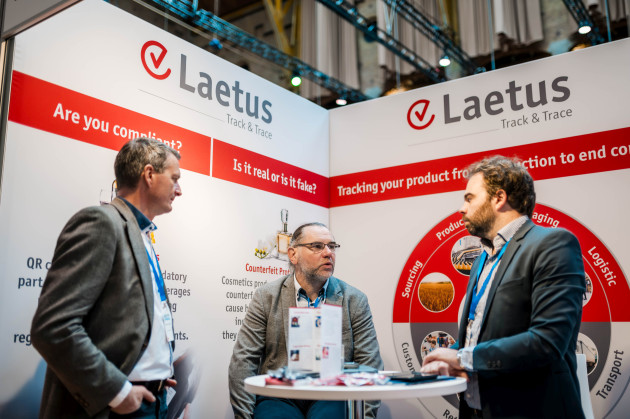Sustainability was a strong theme at the annual Active & Intelligent Packaging Association (AIPIA) congress in Amsterdam late last year. Andrew Manly filed this report for PKN.
[Ed's note: Andrew Manly will be participating in the International Packaging Press Organisation (IPPO) Forum sessions at APPEX, on 12 March, running from 2-5pm at the Seminar Theatre. More details here]
The AIPIA World Congress 2023 was once again located in the iconic Beurs van Berlage building in central Amsterdam, this time running alongside the Sustainable Packaging Summit organised by Packaging Europe. So, it was not surprising that a strong undertone of this year’s event was Smart Packaging’s involvement and impact on the world of sustainability. But, as AIPIA managing director Eef de Ferrante, said in his welcome “There is so much more to smart packaging than a role in sustainability.” This was certainly evident in both the innovative range of topics presented and the smart technologies on show in the exhibition area.
Proceedings kicked off with a highly motivational keynote by Marcin Ratajczak of Berlin-based Inuru. The company has developed a range of labels and other devices using printed OLED (organic light emitting diode) technology. With all Inuru staff sporting jackets with OLED features, lighting up patches as they moved, they were perhaps the best advertisement for this ingenious combination of hybrid and printed electronics, literally shining a light on it.

Marcin explained that the company has already worked with several major brands, including Coca-Cola and champagne house Cattier. He announced that the technology was now at a stage where it can be mass produced cost effectively and will commence operations at scale in early 2024. This will open up a whole range of new possibilities, particularly as other features, such as expiry/timer displays can now be added.
Connected packs are the future
On the Smart Insights stage, Simon Jones of Antares Vision Systems made a bold statement: Playtime is over, the intelligent packaging market will be worth $13 billion by 2027, and the digitisation of packaging is inevitable and will have a major impact on corporate revenues. He explained that his reasoning was driven by the need for data at every level and that packaging suppliers can be empowered to become major suppliers of that data. There is a need to create ‘trustparency’ in supply chains and technologies, such as the Antares Diamind, to deliver end-to-end transparency. This means no more focus group guesswork and a clear message from 90 per cent of packaging suppliers that connected packaging will improve their sustainability credentials. The challenge, he believes, is getting them to act more urgently on this information.
Reinforcing these messages were several companies in the Internet of Things, IoT, space, with Ambient IoT being the latest buzz. Steve Statler of Wiliot led the charge. His presentation covered the latest ambient standards and how these ecosystems, involving 5G and 6G bring a ‘formidable set of new vendors, functionality and marketing dollars’ to the table. He explained that battery-free tags and the power of the cloud and AI can bring the IoT to billions of connected packages.
These messages were echoed later in the Congress by Klaus Simonmeyer of Identiv, who focused on how IoT connected packs can benefit more sensitive sectors such as healthcare and pharma. He announced that a ‘next generation’ set of IoT Pixels are set to be launched in the second half of 2024, which use less power and have the ability to harvest power from ambient light. The company has also developed bitse.io, a new IoT platform.

Success or failure?
A relatively new feature of the Congress are panel discussions to address some more strategic topics. One of these covered Smart Packaging and Sustainability – FMCG insights into what technologies will or won’t succeed. The discussion was led by Tim Sykes of Packaging Europe and featured Amy King and James Harmer of brand product & packaging design and innovation consulting group Cambridge Design Partnership. The discussion centred around whether FMCG companies are ready to implement smart packaging at scale or whether they still need convincing there is a good ROI proposition. They asked the question: ‘Is the smart packaging sector pushing the right technologies?’ and suggested some of the brand priorities have shifted.
In particular, they highlighted supply chain issues and anti-counterfeiting as key concerns and that brands were looking for better, smaller, cheaper on-pack sensors, energy harvesting features, new materials, as well as the need to leverage smartphone devices for direct consumer contact. The sustainability element is also important, for example Holy Grail 2.0, but that is not a consumer facing project.
In a period of change and flux it might be hard to identify the right tech to support, some enabling smart features are still under development, speculated King. But large infrastructure changes will not happen quickly, it will be smaller, incremental changes which can succeed. Consumers have a role to play, particularly in things like food waste prevention, recycle and reuse systems. But they have now been told ‘plastics is bad’ for so long there needs to be a new narrative. And do they always make sustainable choices at the point of purchase.

In the end they concluded brands want one solution which covers a range of requirements (such as track & trace, authentication, tamper evidence, etc.) ‘You cannot put two QR codes on one pack,’ said Harmer. So smart packaging providers need to collaborate to create a joined-up ecosystem – a theme which occurred throughout the Congress. Finally, they see big opportunities in healthcare where legislation and new issues such as compliance are driving packaging outcomes.
Accessible QR codes
Back on the Smart Futures stage another panel covered ‘Making packaging fully accessible for the first time – courtesy of the Accessible QR code’ and featured Sarah Masters, digital & ecommerce director at Unilever who was joined by Mark Powell of the Royal National Institute for the Blind, Caspar Thykier, CEO of Zappar, and Mark Hewitt of Connected Experience Consulting. Masters explained that making its products accessible to everyone in society is not just an important element in Unilever’s diversity and inclusion commitments, it also makes good commercial sense.
The discussion centred around the development of this QR innovation. The panel shared information on the positive impact it is having on the Persil brand and how these and other types of smart accessibility features have a bright future. As ever, a stumbling block is the lack of knowledge about these – as well as other – on pack connective features, and the panel highlighted how it is the responsibility of all the stakeholders to educate those who can benefit from them. The word ‘education’ featured in a number of presentations as a key factor in the implementation and popularisation of connected packaging.
Transparency
The second day of the congress kicked off with another major panel presentation dedicated to the topic Amazon Transparency and the push for global customer trust. This featured people from all sides of the subject. Notably Guneri Tugcu, senior partner manager at Amazon, joined the group, which consisted of Simon Jones of Antares Vision, Dom Guinard, VP of innovation at Digimarc, Nina Zehemair of Securikett, and Fredric Albinyana of Crane Authentication. The session was moderated by Marie Burnay of GS1.
Tugcu explained that the scale of the problem, both counterfeiting and market diversion was huge. The company deals with 33,000 brands, 900 million products and stretches across many countries. He said that Amazon was committed to improving the transparency of the products it sold and working with brands to achieve this. “The first step is sometimes the hardest,” he explained. “Sometimes a small, simple solution is better than nothing,” he added.

From the floor the question was asked if consumers needed better education about connected packaging. Tugcu from Amazon agreed, which is why the company’s transparency program is highly visible. That consumers need to get a good experience from making the connection was also a very important factor. It’s up to brands and retailers to help them make that choice easily.
In conclusion, all agreed education was vital and the GS1 Digital Link was a good route to standardisation and better adoption of connected packaging.
Innovation Stage
As usual at an AIPIA Congress smaller companies with highly innovative smart packaging solutions were given the opportunity on the Innovation Stage to showcase their technologies. Here are just a few:
Brendan Rice of Senoptica introduced its oxygen sensor, printed directly into the MAP lidding film. Once the product has been packed, the sensor is scanned using an in-line scanning system, providing 100 per cent inspection, he explained. Packs are then accepted or rejected based on the specification for that product. Because the sensor is printed into the packaging, the conditions within the pack can be checked at any point in the supply chain using hand-held devices. This gives retailers the ability to conduct spot checks on all product entering their supply chain and the information which allows for strategic price downs and to reduce food waste.
Co-founder of Safer Smart Labels, Lisa Rita Magnaghi explained about the development of its smart labels, which monitor protein foods freshness by chemical recognition of volatile spoilage markers, communicated to the users by the means of visible and real-time colour transition. The company is a spin off from the University of Pavia and its solution uses sensing devices to actually enable the monitoring of food freshness with the naked eye.
Pichaya Pattanasattayavong, CEO of Thailand based Cleantech & Beyond, updated the audience on his company’s Digital Temperature Indicator (DTI), a smart label solution for tracking temperature-sensitive products at item-level. With battery-free operation, the DTI indicates a temperature excursion event both visually and electronically, allowing the status to be monitored manually as well as digitally and wirelessly via RFID/NFC. He announced that the a-Series (from 37°C to 110°C or higher) is now commercially available. The c-Series for cold-chain (4°C to 25°C) will come out next year, around H2 2024.
Aussies participate
Australian company Laava participated at the congress, launching its range of secure connected packaging solutions, including the new ‘Laava Smart Logo’ and ‘Laava Smart QR’ offerings – which complement Laava’s original Smart Fingerprint solution.

CEO Gavin Ger also gave a presentation on ‘Using secure connected packaging to make money for your business’ on the Innovation stage. This focused on using the latest technology to connect directly with end consumers, leveraging the investments a brand would normally make in packaging to protect the integrity of their brand (from counterfeits and grey markets), and to turn the packaging into an ‘always on digital media’ –capable of generating consumer loyalty, repurchase and engagement.
According to Ger, brand owners Laava spoke to were grappling with numerous simultaneous challenges – from legislative compliance for sustainability and recycling, to protecting their brands in export markets, and connecting with consumers pre- and post-purchase. There was a lot of interest in Laava’s two new product offerings – especially for European markets – while exporters familiar with Asian markets were interested in Laava’s extensive case studies from the region.
Take aways
While the Smart Packaging sector is still developing, it continues to grow rapidly and is making a stronger and stronger impact across a range of end-user industries. The need for better data sharing, collaboration and better education about its benefits at all levels – particularly in retailers, brand owners and packaging converters – are paramount. Both the means and momentum are there to create the conditions for success.
This article originally appeared on page 22-24 of the PKN Packaging News magazine.







